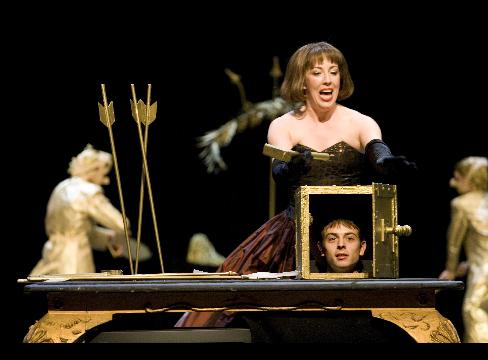This article originally appeared in the Culture section of Bloomberg News on July 19, 2008.

Helen Pickett as Agnes, top, and Jim De Block as Mr. Pnut take part in the Royal Ballet of Flanders production of “Impressing the Czar” on Nov. 22, 2005. The ballet, created by William Forsythe in 1988, will be performed by the Royal Ballet of Flanders at the Rose Theater in New York as part of the Lincoln Center Festival through July 20, 2008. Photographer: Johan Persson/Royal Ballet of Flanders via Bloomberg News
July 19 (Bloomberg) — Imagine an evening-length ballet with two unfathomable sections of pretentious chaos and frenzy surrounding an oasis of logic and calm.
That’s “Impressing the Czar,” created by William Forsythe in 1988 for Ballett Frankfurt, reconstructed by the Royal Ballet of Flanders in 2005 and now brought by that troupe to Manhattan’s Rose Theater, where it runs through tomorrow as part of the Lincoln Center Festival.
Acts I and III are busy and loud, jam-packed with action and lacking in sense but crammed full of stuff: people rushing about to a foolish mix of music; raucous, often patently silly, spoken text; a conglomeration of dance styles, ballet basics predominating; gold-painted props portentously exuding ambiguous meanings; gorgeous or outlandish clothes inspired by different locales and times.
What is Forsythe trying to tell us? In Act I, that past eras of art are rich in treasures but that we’re poor custodians of them, treating them as if they were interchangeable parts of the present moment? In Act III, that the culture, in which everything is for sale, has gone to hell in a hand basket? Your guess is as good as mine, probably better; I have little patience for highbrow shenanigans.
The second of the ballet’s three acts, “In the Middle, somewhat elevated,” has nine dancers in practice clothes, a pair of golden cherries hanging above them, execute an abstract work that Forsythe made for the Paris Opera Ballet in 1987. The next year it became the centerpiece of “Czar” and is now danced on its own by several distinguished classical companies.
Cool Chic
Although the Flanders performers are earthier, less finely honed than the Paris crowd, you can still see the cool chic of the choreography. There’s no postmodern froufrou here; Forsythe relies on the intricacies and beauties of more complex classical steps and on form and pattern, mingled judiciously with pedestrian actions like strolling, running and just hanging out, watching. It did him a world of good.
Aki Saito stood out in this section, her movement now like the slice of a lethally sharp knife, now melting like chocolate in the sun.
The inordinately ambitious choreographer is trying to do three things in “Impressing the Czar.” Not content with emulating Balanchine with “In the Middle,” he wants to outdo him. Balanchine took Marius Petipa’s 19th-century achievement forward, building from it — and from his own genius — ballets that would define classical dance in the 20th century and beyond.
No Balanchine
Forsythe, certainly a talent though hardly on the scale of Balanchine, wants to be the man who revitalizes the genre for the 21st century. Yet his deconstruction of the technique he’s inherited from his role model remains theoretical — handsome enough but devoid of feeling.
In the first and final acts, Forsythe wants to indulge his interest in art and architecture, which is keen, tasteful, even imaginative — though it often overwhelms the movement. He also seems to think that if spectators fail to be impressed by the intellectual underpinning he claims for his choreography, they’ll find some thrills in the gaudy chaos and violence to which he gives full rein in this rule-breaking extravaganza.
It’s easy to see that these aims are incompatible.
At the Rose Theater, Broadway at West 60th Street; +1-212-721-6500; http://www.lincolncenter.org.
© 2008 Bloomberg L.P. All rights reserved. Reprinted with permission.



